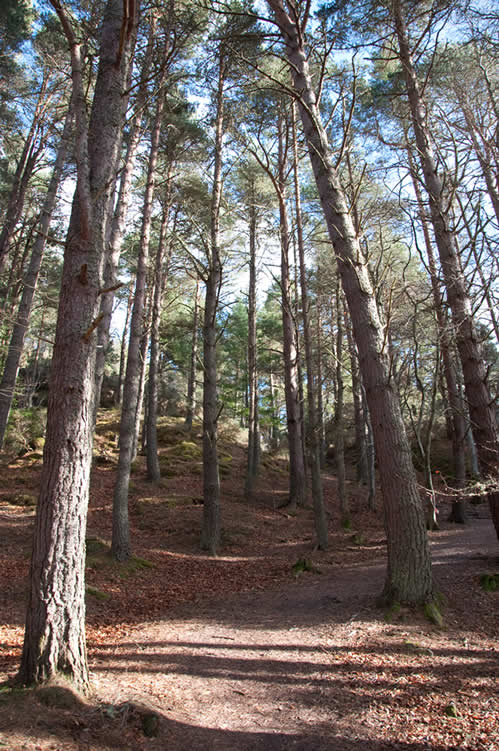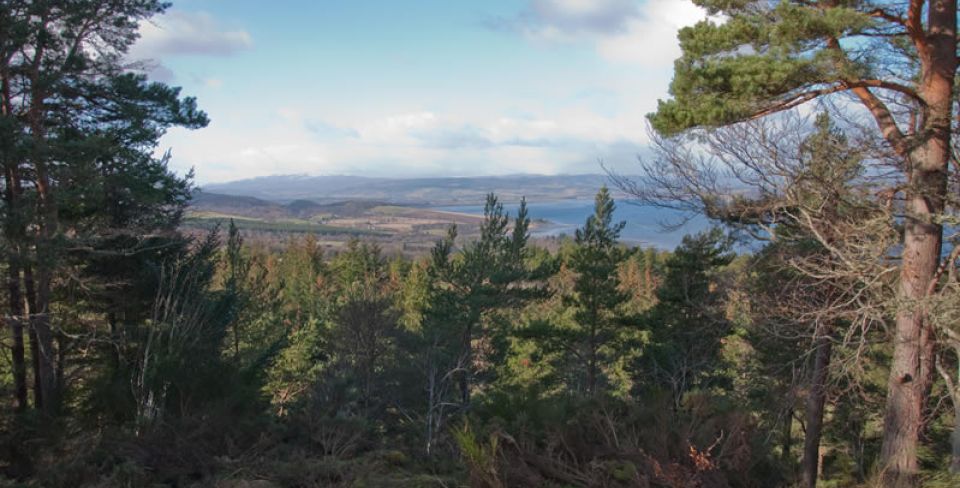8.5 Craig Phadraig
Craig Phadraig is a wooded hill on the edge of Inverness. Follow the path up the hill to discover the possible remains of King Brude’s fort.
Colmcille’s biographer Adomnán describes the saint visiting King Brude, the Pictish king, at his fort somewhere near the River Ness – possibly here at Craig Phadraig – in 565.
Colmcille came here to ensure that King Brude and the other Pictish kings would allow his monks to travel safely in the Western Isles and the Orkney Isles.
In Adomnán’s ‘Life of St Columba‘ there are several stories which recount Colmcille’s long journey to Craig Phadraig. The stories describe occasions when Colmcille performed miracles or confronted danger. These include an encounter with a monster in the River Ness. Some say this is the source of the Loch Ness monster legend.
“Once, on another occasion, when the blessed man stayed for some days in the land of the Picts, he had to cross the River Ness. When he reached its bank, he saw some of the local people burying a poor fellow. They said they had seen a water beast snatch him and maul him savagely as he was swimming not long before. Although some men had put out in a little boat to rescue him, they were too late, but, reaching out with hooks, they had hauled in his wretched corpse. The blessed man, having been told all this, astonished them by sending one of his companions to swim across the river and sail back to him in a dinghy that was on the further bank. At the command of the holy and praiseworthy man, Luigne moccu Min obeyed without hesitation. He took off his clothes except for a tunic and dived into the water. But the beast was lying low on the riverbed, its appetite not so much sated as whetted for prey. It could sense that the water above was stirred by the swimmer, and suddenly swam up to the surface, rushing open-mouthed with a great roar towards the man as he was swimming midstream. All the bystanders, both the heathen and the brethren, froze in terror, but the blessed man looking on raised his holy hand and made the sign of the cross in the air, and invoking the name of God, he commanded the fierce beast, saying:
‘Go no further. Do not touch the man. Go back at once.’
At the sound of the saint’s voice, the beast fled in terror so fast one might have thought it was pulled back with ropes. But it had got so close to Luigne swimming that there was no more than the length of a pole between man and beast. The brethren were amazed to see that the beast had gone and that their fellow-soldier Luigne returned to them untouched and safe in the dinghy, and they glorified God in the blessed man. Even the heathen natives who were present at that time were so moved by the greatness of the miracle they had witnessed that they too magnified the God of the Christians.”
Life of St Columba by Adomnán of Iona, Book II Story 27
Colmcille came to ask King Brude for protection for his monk Cormac Ui Liathain who was travelling in the Orkney Isles. The Pictish king in the Orkneys was subject to King Brude’s authority.
Colmcille was a powerful political figure. He also had connections with the King of the Britons, Riderch, who had his stronghold at Dumbarton (west of modern Glasgow) and who ruled a kingdom in the area around the River Clyde and beyond.
In his accounts, Adomnán describes Colmcille’s arrival at Brude’s Fort.

The fort at Craig Phadraig dates from c.4th century BC. In Colmcille’s time it was possibly the base of King Brude, king of the Picts.
You can still clearly see the outline of the fort’s inner walls. They are about 10 metres thick and enclose an area which is 75 metres long and 23 metres wide. The fort may have had four towers, one at each corner.
Craig Phadraig is a vitrified fort. When the fort was being constructed, no cement or lime was used between the stones in the walls. Instead a fire was lit and the walls were heated to such an extent that the rocks fused together.
The remains of an outer wall lie below the inner area and now look like a terrace of flatter land at the top of the hill.
Traces of a third wall have been found lower down the hill.
Tarbat Ness
- 8.1 Tarbat Discovery Centre, Portmahomack
Between 1994 and 2007 archaeologists excavated an area around the church of St Colman at Portmahomack on the tip of Tarbat Ness. They discovered an extensive monastic settlement dating from the late 6th century. The Tarbat Discovery Centre tells the story of this Christian settlement and its re-discovery by archaeologists....
- 8.2 Hilton of Cadboll
Tarbat Ness is home to a number of standing stones which reflect the artistic skill and Christian faith of the Pictish people who carved them. The stones may have marked the boundary of the lands controlled by the monastery at Portmahomack. The cross-slab at Hilton of Cadboll is a replica...
- 8.3 Shandwick
The cross-slab stone at Shandwick is covered with Christian symbols. This is an expression of Pictish Christianity rather than being a stone which combines pagan and religious designs. There were probably a number of monastic settlements along this coast under control of the large monastery at nearby Portmahomack. The stone...
- 8.4 Nigg Stone
The Nigg Stone is one the finest carved Pictish stones. It was carved around 800AD - or perhaps earlier - and is covered in Christian symbols From the details of this carved stone, it is clear that there were close links between monks living in Nigg and Portmahomack, and the...
- 8.5 Craig Phadraig
Craig Phadraig is a wooded hill on the edge of Inverness. Follow the path up the hill to discover the possible remains of King Brude’s fort. Colmcille’s biographer Adomnán describes the saint visiting King Brude, the Pictish king, at his fort somewhere near the River Ness - possibly here at...
- 8.6 Other Pictish Stone Sites North of Inverness
Other Pictish stone sites Explore the history of the Picts along the east coast from Inverness northwards. The Highland Pictish Trail Trail highlighting 17 sites with Pictish stones, ranging from Inverness to Dunrobin near Golspie. A Catalogue of Pictish Stones at Inverness Museum and Art Gallery The catalogue lists all...










Bòrd na Gàidhlig
Great Glen House
Leachkin Road
Inverness
Scotland, IV3 8NW
(+44) 01463 225454
colmcille@gaidhlig.scot
Colmcille
Foras na Gaeilge, 2-6 Queen Street
Belfast
Northern Ireland
BT1 6ED
(+44) 028 9089 0970
colmcille@forasnagaeilge.ie
Colmcille
Foras na Gaeilge, An Chrannóg
Na Doirí Beaga
Gaoth Dobhair
Donegal, Ireland. F92 EYT3
(+353) 074 9560113
colmcille@forasnagaeilge.ie


